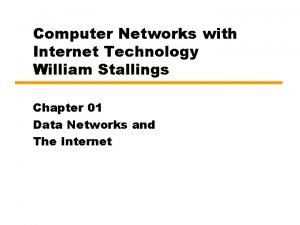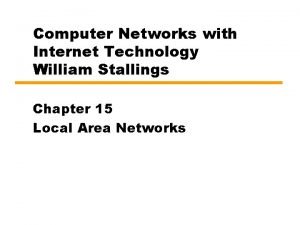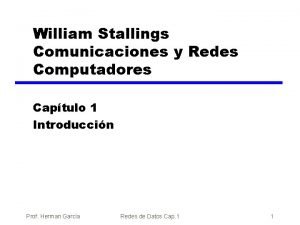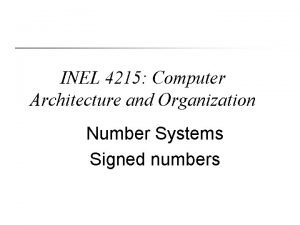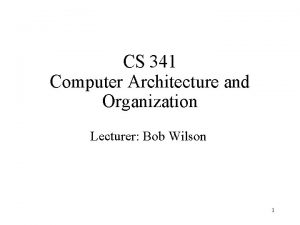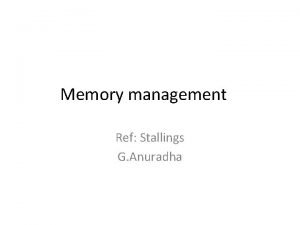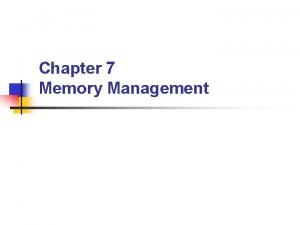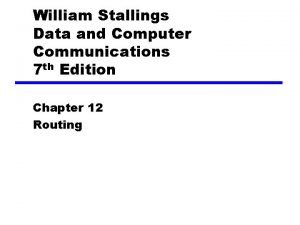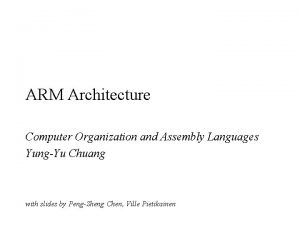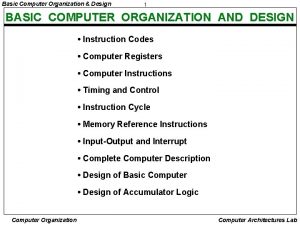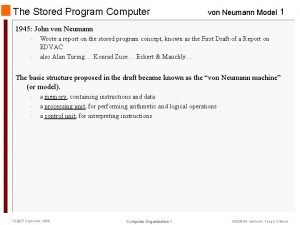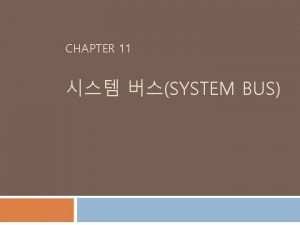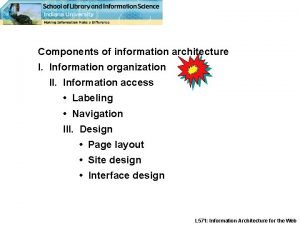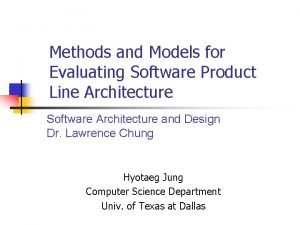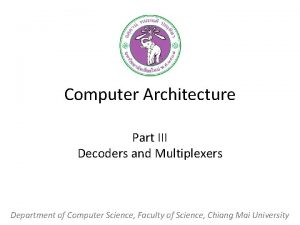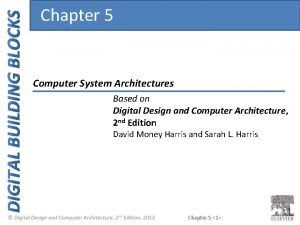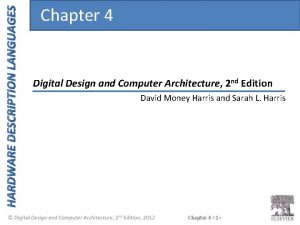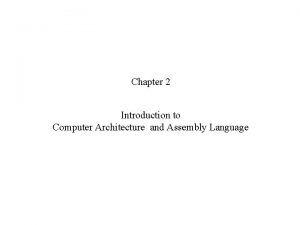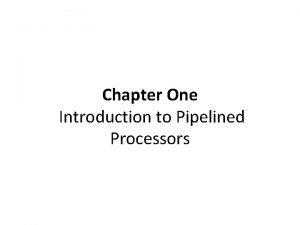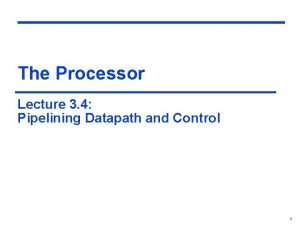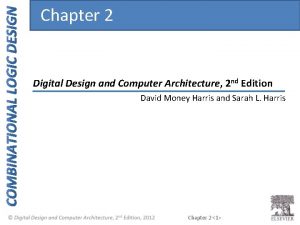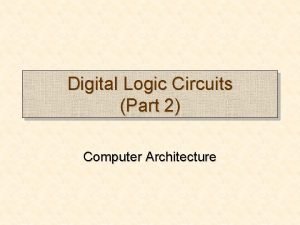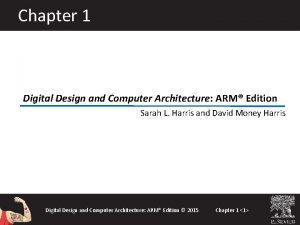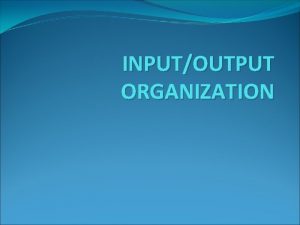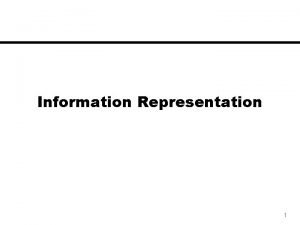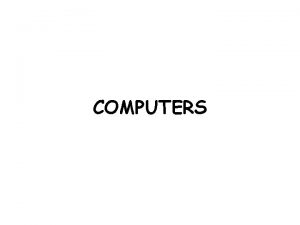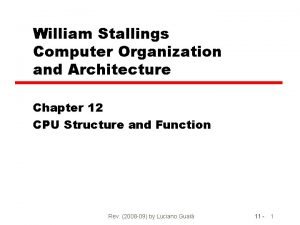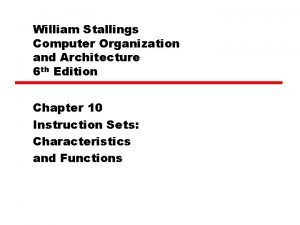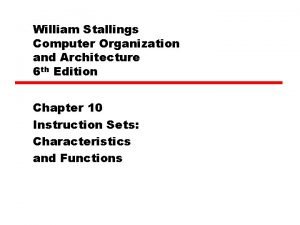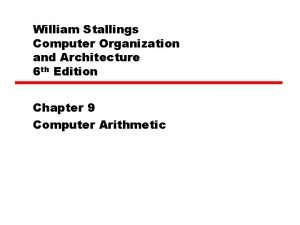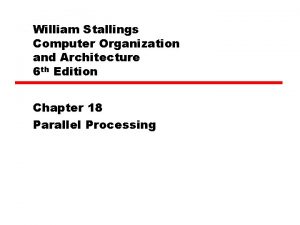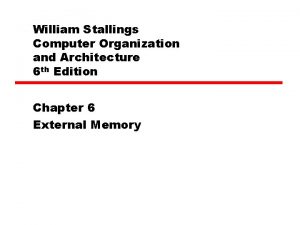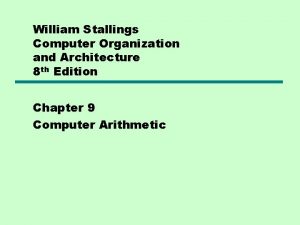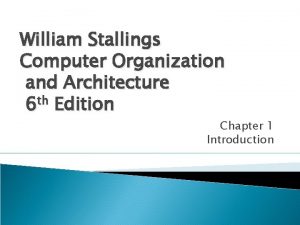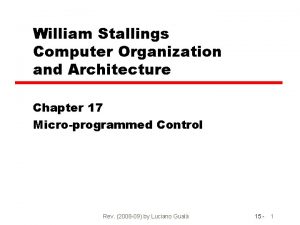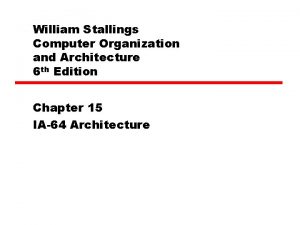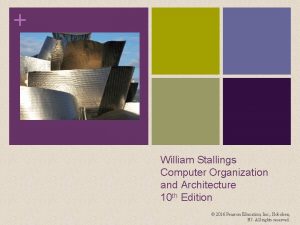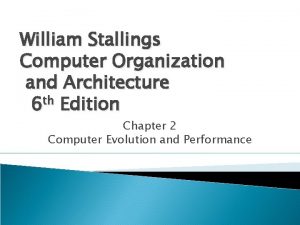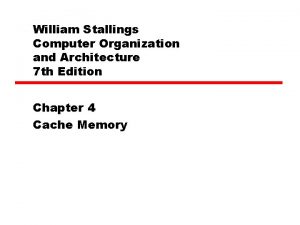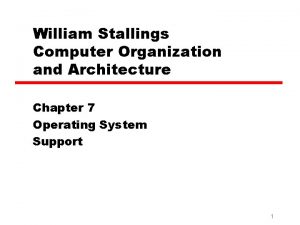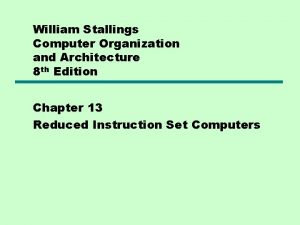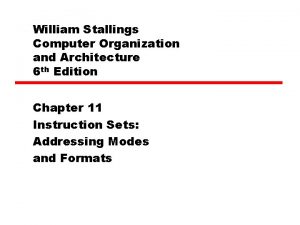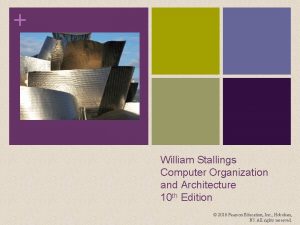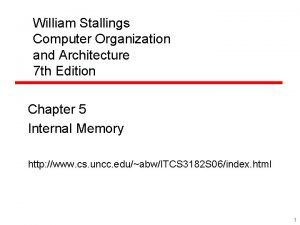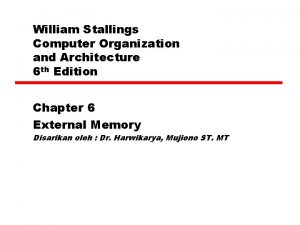William Stallings Computer Organization and Architecture 6 th


























































- Slides: 58

William Stallings Computer Organization and Architecture 6 th Edition Chapter 4 Cache Memory (快取,快速緩衝貯存區)


Location • CPU — Registers, Control Memory • Internal —Cache —Main Memory • External — Disk, Tape, …

Capacity • Word size —The natural unit of organisation —Number of bits to represent a number —Instruction length • Number of words —or Bytes (External)

Unit of Transfer • Internal —Usually governed by data bus width • External —Usually a block which is much larger than a word • Addressable unit 唯一地 —Smallest location which can be uniquely addressed —Word internally A: Length of an address (in bits) —Cluster on disks N: Number of addressable units 叢、群 A N=2

Access Methods (1) • Sequential (循序的) —Start at the beginning and read through in order —Access time depends on location of data and previous location —e. g. tape • Direct —Individual blocks have unique address —Access is by jumping to vicinity plus sequential search 附近 —Access time depends on location and previous location —e. g. disk

Access Methods (2) • Random —Individual addresses identify(確認) locations exactly —Access time is independent of location or previous access —e. g. RAM (Random Access Memory) • Associative (聯想的) —Data is located by a comparison with contents of a portion of the store —A word is retrieved (取回) based on a portion of its contents rather than its address —Access time is independent of location or previous access —e. g. cache

Performance • Access time (latency 潛伏、遲延) —Time between presenting the address and getting the valid data (RAM) —Time it takes to position the read-write mechanism at the desired location (non-random-access memory) • Memory Cycle time —Time may be required for the memory to “recover” (eg. destructively read) before next access —Cycle time is access + recovery • Transfer Rate —Rate at which data can be moved

Transfer Rate • RAM — 1/(cycle time) • Non-random-access memory N TN = TA + — R TN TA N R = = Average time to read or write N bits Average access time Number of bits Transfer rate (bps)

Physical Types • Semiconductor —RAM • Magnetic —Disk & Tape • Optical —CD & DVD • Others —Bubble (磁泡) —Holographic (Optical 3 D storage)

Physical Characteristics • • Decay (衰減) Volatility (揮發性) Erasable Power consumption

Organization • Physical arrangement of bits into words • Not always obvious • e. g. interleaved (交錯)

Memory Hierarchy • Registers —In CPU • Internal or Main memory —May include one or more levels of cache —“RAM” • External memory —Backing store

Memory Hierarchy - Diagram MO: Magneto Optical WORM: Write Once, Read Many

The Bottom Line • How much? —Capacity • How fast? —Time is money • How expensive?

Hierarchy List • • Registers L 1 Cache L 2 Cache Main memory Disk cache Disk Optical Tape

So you want fast? • It is possible to build a computer which uses only static RAM (see later) • This would be very fast • This would need no cache —How can you cache? • This would cost a very large amount

Locality (位置) of Reference (參考) • During the course of the execution of a program, memory references tend to cluster • e. g. loops • Spatial (空間的) Locality Page 129 — The tendency (傾向) of execution to involve (包括) a number of memory locations that are clustered • Temporal (暫時的) Locality — The tendency for a processor to access memory locations that have been used recently. Appendix 4 A

Cache • Small amount of fast memory • Sits between normal main memory and CPU • May be located on CPU chip or module

Cache/Main Memory Structure 1 Block = K words Memory: 2 n words, M Blocks (M = 2 n/K) Cache: C Blocks (Lines) C << M

Cache operation - Overview • • CPU requests contents of memory location Check cache for this data If present, get from cache (fast) If not present, read required block from main memory to cache • Then deliver from cache to CPU • Cache includes tags to identify which block of main memory is in each cache slot (槽)

Cache Read Operation - Flowchart

Cache Design

Size does matter • Cost —More cache is expensive • Speed —More cache is faster (up to a point) —Checking cache for data takes time

Typical Cache Organization

Mapping Function • Example: —Cache of 64 KByte (216 bytes) —Cache block of 4 bytes – i. e. cache is 16 k (214) lines of 4 bytes —Main memory: 16 MBytes – 24 bit address (224=16 M) 1 KBytes = 210 bytes 1 MBytes = 220 bytes 1 GBytes = 230 bytes

Direct Mapping • Each block of main memory maps to only one cache line —i. e. if a block is in cache, it must be in one specific place • • Address is in two parts (Significant: 顯著的) Least Significant w bits identify unique word Most Significant s bits specify one memory block The MSBs are split into a cache line field r and a tag of s-r (most significant) s bits w bits s-r bits w bits tag line # word #

Direct Mapping Address Structure Tag s-r 8 Line or Slot r Word w 14 • 24 bit address • 2 bit word identifier (4 byte block) • 22 bit block identifier — 8 bit tag (=22 -14) — 14 bit slot or line (214 lines in cache) • No two blocks in the same line have the same Tag field • Check contents of cache by finding line and checking Tag 2

Direct Mapping Cache Line Table Cache line (i) (j ) 0 m 1 m+1 Main Memory blocks held 0, m, 2 m, … 2 s- 1, m+1, 2 m+1, … 2 s- i =m-1 j modulo m , where m is 2 m-1, the number in cache m-1, 3 m-1, of…lines 2 s-1 modulo (以. . . 為模) 17 mod 6 = 5 20 mod 8 = 4

Direct Mapping Cache Organization 1 2 4‘ 3 4

Direct Mapping Example

Direct Mapping Summary • Address length = (s + w) bits • Number of addressable units = 2 s+w words or bytes • Block size = line size = 2 w words or bytes • Number of blocks in main memory = 2 s+w/2 w = 2 s • Number of lines in cache = m = 2 r • Size of tag = (s – r) bits

Direct Mapping pros & cons • Simple • Inexpensive • Fixed location for given block —If a program accesses 2 blocks that map to the same line repeatedly, cache misses are very high

Associative Mapping • A main memory block can load into any line of cache • Memory address is interpreted as tag and word • Tag uniquely identifies block of memory • Every line’s tag is examined for a match • Cache searching gets expensive

Fully Associative Cache Organization 1 2 2‘

Associative Mapping Example 3 9 C 0011100 E 7

Associative Mapping Address Structure Tag 22 bit Word 2 bit • 22 bit tag stored with each 32 bit block of data • Compare tag field with tag entry in cache to check for hit • Least significant 2 bits of address identify which word is required from 32 bit data block • e. g. —Address Tag —FFFFFC 3 FFFFF related Data 2468 * not related Cache line 3 FFF

Associative Mapping Summary • • • Address length = (s + w) bits Number of addressable units = 2 s+w words or bytes Block size = line size = 2 w words or bytes Number of blocks in main memory = 2 s+ w/2 w = 2 s Number of lines in cache = undetermined (未確定的) Size of tag = s bits (not determined by address format)

Set Associative Mapping • Cache is divided into a number of sets (v sets) • Each set contains a number of lines ( k lines) m = v k, where m is the number of lines in cache • A given block maps to any line in a given set — e. g. Block j can be in any line of set i i = j modulo v • e. g. 2 (k) lines per set — 2 (k) way associative mapping —A given block can be in one of 2 (k) lines in only one set

Two Way Set Associative Cache Organization v = 2 d 1 3‘ 2 3

Set Associative Mapping Address Structure Tag 9 bit Word 2 bit Set 13 bit • Use set field to determine cache set to look in • Compare tag field to see if we have a hit • e. g —Address — 1 FF 7 FFC — 001 7 FFC Tag 1 FF 001 Data 12345678 11223344 related Set number 1 FFF

Two Way Set Associative Mapping Example

Set Associative Mapping Example • 13 bit set number (i. e. 213 sets) • Block number in main memory is modulo 213 • 000000, 008000, …, FF 8000 map to set 0

Set Associative Mapping Summary • • Address length = (s + w) bits Number of addressable units = 2 s+w words or bytes Block size = line size = 2 w words or bytes Number of blocks in main memory = 2 s Number of lines in set = k Number of sets = v = 2 d Number of lines in cache = kv = k * 2 d Size of tag = (s – d) bits

Assignment 2 • Cache size: 512 KBytes • Cache block size: 32 Bytes • Main memory size: 2 GBytes • What is the address format of — Direct Mapping — Fully Associative — 4 -way Associative

Replacement Algorithms (1) Direct mapping • No choice • Each block only maps to one line • Replace that line

Replacement Algorithms (2) Associative & Set Associative • • • Hardware implemented(實行) algorithm (speed) Least Recently used (LRU) best hit ratio e. g. in 2 way set associative —Which of the 2 block is lru? (USE bit per line) • First in first out (FIFO) —replace block that has been in cache longest • Least frequently used (LFU) (use counters) —replace block which has had fewest hits • Random

Write Policy • Must not overwrite a cache block unless main memory is up to date • Multiple CPUs may have individual caches • I/O may address main memory directly

Write through • All writes go to main memory as well as cache • Multiple CPUs can monitor main memory traffic to keep local (to CPU) cache up to date • Lots of traffic • Slows down writes

Write back • Updates initially made in cache only • Update bit for cache slot is set when update occurs • If block is to be replaced, write to main memory only if update bit is set • Other caches get out of sync • I/O must access main memory through cache • 15% of memory references are writes

Cache Coherency (一致性) • Bus watching with write through — Each cache controller monitor the bus. • Hardware Transparency (透通性) — use additional hardware to ensure that all updates to main memory via cache are reflected in all caches. • Noncacheable Memory —Only a portion of main memory (noncacheable) is shared by more than one processor.

Other Issues • Line Size —By principle of locality, the hit ratio at first increases when the block size increases. —When the block size becomes even bigger, the hit ratio begin to decrease. • Number of Caches —Multilevel Caches – On-chip cache (L 1) – Off-chip (external) cache (L 2) —Unified vs. Split Caches – Data cache / Instruction cache

Pentium 4 Cache • 80386 – no on chip cache • 80486 – 8 k using 16 byte lines and four way set associative organization • Pentium (all versions) – two on chip L 1 caches — Data & instructions • Pentium 4 – L 1 data caches — 8 k bytes — 64 byte lines — four way set associative • L 2 cache — Feeding both L 1 caches — 256 k — 128 byte lines — 8 way set associative

Pentium 4 Diagram (Simplified)

Pentium 4 Core Processor • Fetch/Decode Unit — Fetches instructions from L 2 cache — Decode into micro-ops — Store micro-ops in L 1 cache • Out of order execution logic — Schedules micro-ops — Based on data dependence and resources — May speculatively execute • Execution units — Execute micro-ops — Data from L 1 cache — Results in registers • Memory subsystem — L 2 cache and systems bus

Pentium 4 Design Reasoning • Decodes instructions into RISC like micro-ops before L 1 cache • Micro-ops fixed length — Superscalar pipelining and scheduling • Pentium instructions long & complex • Performance improved by separating decoding from scheduling & pipelining — (More later – ch 14) • Data cache is write back — Can be configured to write through • L 1 cache controlled by 2 bits in register — CD = cache disable — NW = not write through — 2 instructions to invalidate (flush) cache and write back then invalidate

Comparison of Cache Sizes

Itanium
 Computer arithmetic
Computer arithmetic Simplified data communication model
Simplified data communication model William stallings computer networks
William stallings computer networks William stallings computer networks
William stallings computer networks Network security essentials 5th edition pdf
Network security essentials 5th edition pdf Kr
Kr William stallings
William stallings Congruence relation
Congruence relation Stallings william comunicaciones y redes de computadores
Stallings william comunicaciones y redes de computadores Cryptography william stallings
Cryptography william stallings Difference between computer architecture and organization
Difference between computer architecture and organization Computer organization and architecture 10th solution
Computer organization and architecture 10th solution Virtual lab computer organization
Virtual lab computer organization Introduction to computer organization and architecture
Introduction to computer organization and architecture Computer organization & architecture: themes and variations
Computer organization & architecture: themes and variations Computer organization and architecture 10th edition
Computer organization and architecture 10th edition Computer organization and architecture definition
Computer organization and architecture definition 1 s complement
1 s complement Computer architecture and organization
Computer architecture and organization Process organization in computer organization
Process organization in computer organization Bus design in computer architecture
Bus design in computer architecture Instruction set architecture in computer organization
Instruction set architecture in computer organization Memory organisation in computer architecture
Memory organisation in computer architecture Basic structure of computer in computer organization
Basic structure of computer in computer organization Basic computer design
Basic computer design Design of basic computer
Design of basic computer Stallings garbage pickup
Stallings garbage pickup Stallings garbage pickup
Stallings garbage pickup How did daphne react to her admirers
How did daphne react to her admirers Metodo stallings
Metodo stallings Least cost routing algorithm
Least cost routing algorithm Compare and contrast organization
Compare and contrast organization Arm in computer organization
Arm in computer organization Interrupt cycle flow chart
Interrupt cycle flow chart Basic computer organization and design
Basic computer organization and design Neumann dst
Neumann dst Synchronous and asynchronous bus in computer organization
Synchronous and asynchronous bus in computer organization Call and return architecture in software architecture
Call and return architecture in software architecture Components of information architecture
Components of information architecture Bapo business architecture process organization
Bapo business architecture process organization Timing and control in computer architecture
Timing and control in computer architecture Computer architecture: concepts and evolution
Computer architecture: concepts and evolution Digital design and computer architecture arm edition
Digital design and computer architecture arm edition Linear and non linear pipeline
Linear and non linear pipeline Digital design and computer architecture
Digital design and computer architecture Multiplexer in computer
Multiplexer in computer Digital design and computer architecture
Digital design and computer architecture Digital design and computer architecture
Digital design and computer architecture Assembly language and computer architecture
Assembly language and computer architecture Hazard detection and resolution
Hazard detection and resolution Pipeline datapath
Pipeline datapath Bubble pushing example
Bubble pushing example Digital logic and computer architecture
Digital logic and computer architecture Apollo guidance computer manual
Apollo guidance computer manual Digital design and computer architecture: arm edition
Digital design and computer architecture: arm edition Nano programming in computer architecture
Nano programming in computer architecture Accessing io devices in computer organization
Accessing io devices in computer organization Information representation
Information representation Basic organization of digital computer
Basic organization of digital computer


